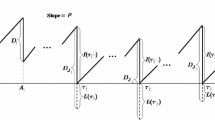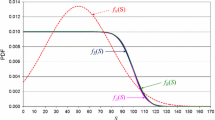Abstract
This paper addresses the problem of inventory penalty pricing under the risk-neutral valuation principle. The underlying production-inventory system has a constant replenishment rate and a compound renewal demand stream (i.e., iid demand interarrival times are independent of iid demand sizes), and is subject to underage and overage penalties. Our pricing approach treats the penalties as a series of perpetual American options, and constructs auxiliary martingale processes in term of the inventory process. We provide a necessary and sufficient martingale condition for general compound renewal demands. Explicit expressions of penalty functions for underage and overage are obtained for the case where demand arrivals follow a Poisson process.





Similar content being viewed by others
References
Ernst, R., & Powell, S. G. (1995). Optimal inventory policies under service-sensitive demand. European Journal of Operational Research, 87(2), 316–327.
Hull, J. C. (2002). Options, futures, and other derivative securities (5th ed.). New York: Prentice Hall.
Gerber, H. U., & Shiu, E. S. W. (1994). Martingale approach to pricing perpetual American options. ASTIN Bulletin, 24(2), 195–220.
Gerber, H. U., & Shiu, E. S. W. (1996). Martingale approach to pricing perpetual American options on two stocks. Mathematical Finance, 6(3), 303–322.
Gerber, H. U., & Shiu, E. S. W. (1998). On the time value of ruin. North American Actuarial Journal, 2, 48–78.
Karr, A. F. (1993). Probability. Berlin: Springer.
Luenberger, D. G. (1998). Investment science. London: Oxford University Press.
Ofenbakh, I. (2008). Estimation of lost sales revenue opportunity due to out of stock inventory. In INFORMS, 29 October, 2008, NY, USA.
Relph, G., & Barrar, P. (2003). Overage inventory—how does it occur and why is it important? International Journal of Production Economics, 81–82, 163–171.
Ross, S. M. (1996). Stochastic processes (2nd ed.). New York: Wiley.
Schwartz, B. L. (1966). A new approach to Stockout penalties. Management Science, 12, 538–544.
Schwartz, B. L. (1970). Optimal inventory policy in perturbed demand models. Management Science, 16, B509–B518.
Stowe, J. D., & Su, T. (1997). A contingent-claims approach to the stocking decision. Financial Management, 26(4), 42–58.
Walter, C. K., & Grabner, J. R. (1975). Stockout cost models: empirical tests in a retail situation. The Journal of Marketing, 39(3), 56–60.
Zipkin, P. (2000). Foundations of inventory management (pp. 25–26). Boston: McGraw Hill.
Author information
Authors and Affiliations
Corresponding author
Appendix
Appendix
Proof of Lemma 1
Substituting Eq. (3.1) into Eq. (2.10) and noting that I(t) and M(t) determine each other for each t, we rewrite the left hand side of Eq. (2.6) for any 0≤i≤j as

For the embedded martingale condition to hold, it is necessary and sufficient that the right-most side of Eq. (8.1) be equal to M(A i ), which is equivalent to the condition

Equation (3.3) now readily follows, since \(\tilde{f}_{T}(r - c \rho)\tilde{f}_{D}(c)\) is non-negative. □
Proof of Lemma 2
To prove part (a), we show that the derivatives of l T (c) satisfy


Equation (8.2) follows from the facts


where Eq. (8.4) is an immediate consequence of the Laplace transform, and Eq. (8.5) follows by the Leibniz integral rule.
To prove (8.3), note that the denominator is positive, so it remains to show that the numerator is positive too. Differentiating Eq. (8.5) with the aid of the Leibniz integral rule yields

Substituting (8.4), (8.5) and (8.6) into the numerator of Eq. (8.3), the latter becomes

Finally, applying the Cauchy-Schwarz inequality (Karr 1993) to the product of expectations in the first term of Eq. (8.7) results in the inequality,

where the strict inequality follows from the fact that the random variables on the left-hand side above are not proportional to each other. Equation (8.8) establishes that the numerator of Eq. (8.3) is positive, thereby completing the proof of part (a).
To prove part (b), we apply an argument similar to that for part (a). Accordingly, we show that the derivatives of l D (c) satisfy


Equation (8.9) follows from the facts


where Eq. (8.11) is an immediate consequence of the Laplace transform, and Eq. (8.12) follows by the Leibniz integral rule.
To prove Eq. (8.10), note that the denominator is positive, so it remains to show that the numerator is positive too. Differentiating Eq. (8.12) with the aid of the Leibniz integral rule yields,

Substituting Eqs. (8.11), (8.12) and (8.13) into the numerator of Eq. (8.10), the latter becomes

Finally, applying the Cauchy-Schwarz inequality to the first term of Eq. (8.14) results in the inequality,

where the strict inequality follows from the fact that the random variables on the left-hand side above are not proportional to each other. Equation (8.15) establishes that the numerator of Eq. (8.10) is positive, thereby completing the proof of part (b). □
Proof of Proposition 3
Let D denote a generic exponential demand size with pdf f D (x)=βe −βx,β>0. By Lemma 3 we can write

where the second equality follows from the memorylessness of the exponential distribution.
Define the functions

and

Next, we rewrite Eq. (8.17) as

where the first equality holds by the chain rule of conditional probabilities,

and the second equality follows from Eq. (8.16) combined with the fact that \(f_{L(\tau _{1}^{(0)})| I(\tau _{1}^{(0)} - ),\tau _{1}^{(0)}, I(0)} = f_{L(\tau _{1}^{(0)})| I(\tau _{1}^{(0)} - )}\). In view of Eqs. (8.18) and (8.19), we now have

Furthermore, integrating both sides of Eq. (8.18) with respect to x from zero to infinity, we get

Next, we write

Here, the first equality follows from the fact that \(L(\tau_{1}^{(0)}) =- I(\tau_{1}^{(0)})\), the second and third equality hold by definition, the fourth equality holds by Eq. (8.20), the fifth equality follows from (8.21), and the sixth equality is a consequence of exponentially distributed demand sizes. Finally, the above equation equals \(e^{c_{1}u}\) by Eq. (5.4), which completes the proof. □
Rights and permissions
About this article
Cite this article
Shi, J., Katehakis, M.N. & Melamed, B. Martingale methods for pricing inventory penalties under continuous replenishment and compound renewal demands. Ann Oper Res 208, 593–612 (2013). https://doi.org/10.1007/s10479-012-1130-5
Published:
Issue Date:
DOI: https://doi.org/10.1007/s10479-012-1130-5




